| کد مقاله | کد نشریه | سال انتشار | مقاله انگلیسی | نسخه تمام متن |
|---|---|---|---|---|
| 5779922 | 1634692 | 2017 | 14 صفحه PDF | دانلود رایگان |
- We develop a 2000-year-long, seven-event earthquake record for the Alpine Fault.
- We use a 27-event earthquake record to refine seismic hazard estimates.
- Earthquakes recur every 291±23 years on the southern onshore Alpine Fault.
- Regular earthquake recurrence is indicated by a coefficient of variation of 0.41.
- Sediments in fault-adjacent wetlands provide high-resolution earthquake records.
Discovery and investigation of millennial-scale geological records of past large earthquakes improve understanding of earthquake frequency, recurrence behaviour, and likelihood of future rupture of major active faults. Here we present a â¼2000 year-long, seven-event earthquake record from John O'Groats wetland adjacent to the Alpine fault in New Zealand, one of the most active strike-slip faults in the world. We linked this record with the 7000 year-long, 22-event earthquake record from Hokuri Creek (20 km along strike to the north) to refine estimates of earthquake frequency and recurrence behaviour for the South Westland section of the plate boundary fault. Eight cores from John O'Groats wetland revealed a sequence that alternated between organic-dominated and clastic-dominated sediment packages. Transitions from a thick organic unit to a thick clastic unit that were sharp, involved a significant change in depositional environment, and were basin-wide, were interpreted as evidence of past surface-rupturing earthquakes. Radiocarbon dates of short-lived organic fractions either side of these transitions were modelled to provide estimates for earthquake ages. Of the seven events recognised at the John O'Groats site, three post-date the most recent event at Hokuri Creek, two match events at Hokuri Creek, and two events at John O'Groats occurred in a long interval during which the Hokuri Creek site may not have been recording earthquakes clearly. The preferred John O'Groats-Hokuri Creek earthquake record consists of 27 events since â¼6000 BC for which we calculate a mean recurrence interval of 291±23years, shorter than previously estimated for the South Westland section of the fault and shorter than the current interseismic period. The revised 50-year conditional probability of a surface-rupturing earthquake on this fault section is 29%. The coefficient of variation is estimated at 0.41. We suggest the low recurrence variability is likely to be a feature of other strike-slip plate boundary faults similar to the Alpine fault.
Journal: Earth and Planetary Science Letters - Volume 464, 15 April 2017, Pages 175-188
